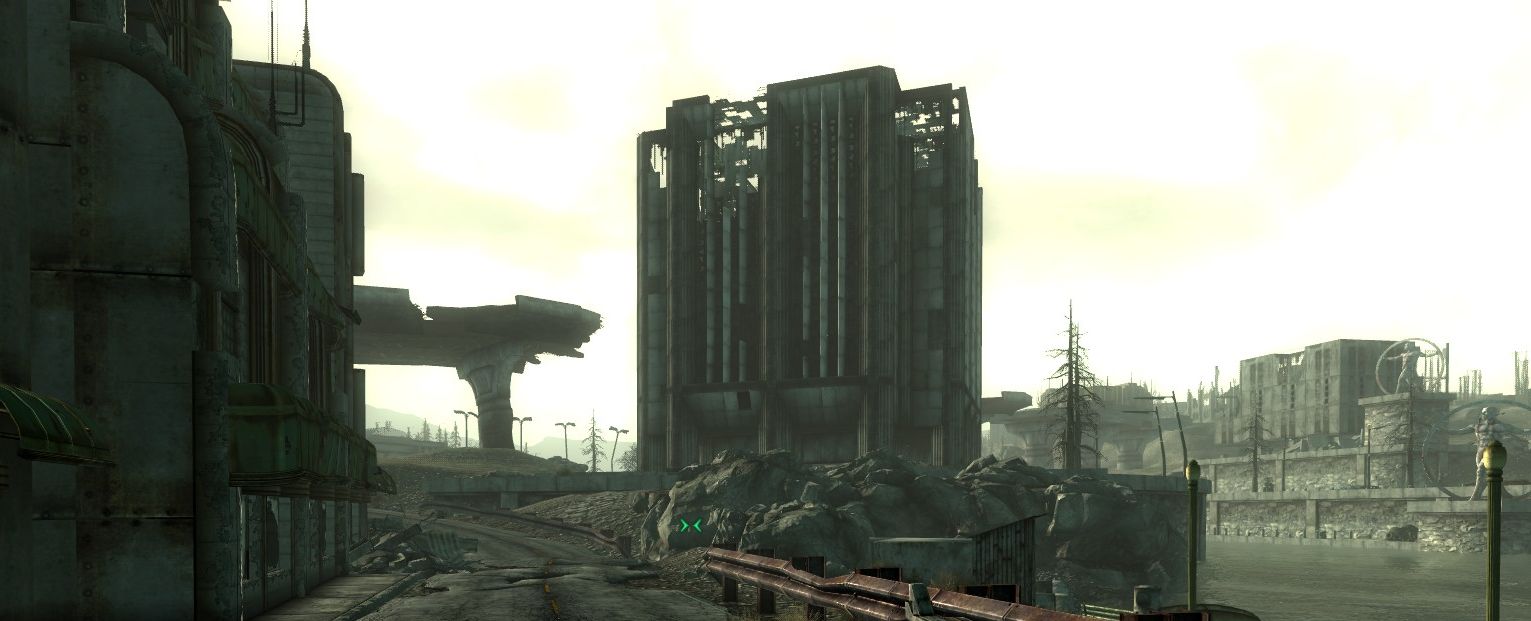Why I love Fallout 3's Capital Wasteland
Sam explains why he prefers Fallout 3 to Skyrim.


In Why I Love, PC Gamer writers pick an aspect of PC gaming that they love and write about why it's brilliant. Today Sam appreciates the view in Fallout 3's Capital Wasteland.
There's a trick to Fallout 3's open world that I don't think any other game has successfully replicated to the same degree: showing something in the distance, whether it's a distinctive-looking building, advertising prop, silhouette or some vague geometry that encourages me to uncover exactly what it is, to see if there's anyone there or maybe a story to uncover. It's definitely not the only game to attempt this, but the context of Fallout 3's desolated landscape makes the horizon an unusually effective device. In this world where there's nowhere and nothing left, you want to see everything.
Skyrim is almost as good at this, but it's really the difference in fiction that makes Fallout 3 pull ahead for me. I've always preferred Fallout 3 over Skyrim, and that's no slight to the scale or detail of the 2011 RPG—it's certainly a more refined game, particularly in combat and progression. But Fallout 3 has a more human premise. As fanciful and pulpy as the various storylines are, the scenario of a nuclear strike is a real-world concern (especially in decades past), which has a more powerful narrative draw to me than high fantasy.
You're experiencing a detailed interpretation of what happens to a populated real-life city in the aftermath of nuclear war. Having that environment be something that players want to explore is a testament to Bethesda's ability to make the grey remnants of human life look extraordinary—and the horizon is the best tool the game has to show that off.
When I first leave Vault 101, I can see the Capitol Building and the Washington Monument off in the distance. When I reach the river, I can make out the statues on the Anchorage memorial. Tenpenny Tower is usually a sign I'm going in the wrong direction. I'm never in the middle of nowhere in Fallout 3—Bethesda mapped the landscape so it's difficult to see nothing in all directions. This layout feeds your sense of exploration. Following the main storyline is a good way to get a tourist's snapshot of each quadrant, but wandering without a waypoint is the way to properly experience that world.
When I first played through Fallout 3 years ago, it was following the skyline that randomly led me to the Oasis sidequest with a nuclear tree man and his insane followers, probably the game's best. Objects and quests aren't randomly placed, but their locations aren't clearly spelled out for you, either. It's a delicate balance of encouraging the player to explore and not making it too hard to further the narrative. No one is better at finding the point in between than Bethesda.
The success of the Capital Wasteland as an environment is based equally in art direction and design. A friend of mine once observed the difference between the art direction of Fallout 3 compared with that of a more colourful, otherworldly locale like something from Final Fantasy 13 is the level of challenge involved in what's being created.

I've thought about that a lot when replaying Fallout 3. Bethesda draws beautiful imagery out of the destruction of the real world—there is some out-there sci-fi iconography in the robot and creature design, but Washington DC is a familiar place and is treated as such. It's designed to provoke us through evoking images of everyday life, and what that would look like if it was suddenly taken away.
Keep up to date with the most important stories and the best deals, as picked by the PC Gamer team.
My friend posited that creating a gorgeous and exciting backdrop out of a nuked real-world location is way harder than building one where there are seemingly no rules as to how colour palette should be used. Replaying Fallout 3 now, I agree with him. There's rubble, destroyed cars, greying fields, no fauna—but it's amazing to look at, even now.
Fallout 3's world is rougher in detail than I remember it, but that urge to explore is the same to me, even though I remember where a lot of the places are. I look up, and I see a rock face in an interesting shape, a broken freeway, a small abandoned town, a centaur wandering by the waterside, some kind of factory—the sky is a grim colour and all the people are gone, but I still want to keep following that horizon.


